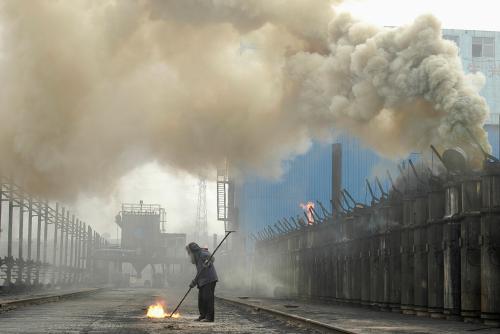Today the White House issued an executive order on domestic energy policy that seeks to hobble or reverse some of broad set of climate and clean energy initiatives developed by the Obama administration, including an important component called the Clean Power Plan that would reduce emissions from electricity generation.
First and most prominently, the executive order directs the Environmental Protection Agency to review the Clean Power Plan, one of Obama’s key regulatory actions to drive down greenhouse gas emissions in the electric power sector. Because an executive order cannot directly overturn a regulation, the EPA will have to come to a finding about whether the CPP should be revised or repealed. Technically, the EPA does not have an option to repeal and not replace, because the Supreme Court has already ruled that the current interpretation of the Clean Air Act—the legislation upon which the CPP is based—requires the EPA to regulate carbon dioxide as a pollutant. Repeal without replacement would contravene the Supreme Court’s order, so Trump’s EPA must come up with an alternative that will hold up in court.
While determining the fate of the CPP will end up being an immensely complex multi-year undertaking, the order also includes the following actions that can be carried out quickly:
- Reversing Obama’s moratorium on new coal mining leases on federal lands;
- Removing the consideration of greenhouse gases from permit reviews under the National Environmental Policy Act;
- Formally abandoning Obama’s roadmap on how to achieve U.S. emissions reductions
- Eliminating a tool for cost-benefit analysis in regulatory review called the “Social Cost of Carbon”
So what are the implications for former President Obama’s climate plans and, more broadly, the overall trajectory of U.S. greenhouse gas emissions?
First, dismantling the CPP would put the U.S. on a higher pollution and less ambitious emissions track in the medium term.
First, dismantling the CPP would put the U.S. on a higher pollution and less ambitious emissions track in the medium term. The CPP targeted a roughly 32 percent decrease in CO2 emissions from the power sector by 2030, primarily from accelerating the long-term shift away from coal-fired electricity generation. In addition to having impacts on the U.S. economy and health, removing the CPP would imply a costly delay in implementing what in the long run will be necessary reductions in our overall greenhouse gas emissions over time. In addition, the approach in the CPP was developed over many years of consultation with industry, health advocates, states, and other stakeholders. While it would impact coal, it did provide a reasonable approach to reducing the most harmful emissions and steering the economy toward a sounder energy system for the future.
The EPA had previously estimated substantial benefits from the CPP, including $14-34 billion in benefits accruing just to health, with 3,600 premature deaths, 1,700 heart attacks, 90,000 asthma attacks, and of 300,000 lost work and school days avoided every year. These are significant impacts that Trump’s EPA will have to justify abandoning—both to constituents and to the courts.
In addition, while Trump argues that the CPP rollback will benefit jobs, he is referring to a relatively small set of interests. While it is important to be mindful of the need to blunt the potential economic hardship that people working in dying industries face, even insiders acknowledge that the coal sector is not going to recover even with these rules rolled back, not least because of mechanization. Recent Department of Energy statistics show that the coal mining industry employed roughly 66,000 miners in 2015, compared to an estimated 3 million jobs supported by clean energy. Therefore, the likely impact of the order on the coal industry will be fairly weak in the near term and, at best, mediocre in the long term. While reversing the moratorium on new coal mining leases will open new sources of supply, it will not in itself reverse the trends in energy markets that have increasingly favored gas. In addition, other regulations to control air pollution will continue to restrict the burning of coal for electricity.
In short, there are better ways to encourage work for those disaffected by the shifting of tectonic plates of the energy economy.
Moreover, removing the regulations may not produce any net jobs, and could in fact cause a net decrease in jobs in the long run. Jobs projections are always somewhat uncertain, and in any jobs comparison, it’s important to think of the economy as a whole. In other words, if we are producing less electricity from new technologies like wind and solar—industries that also promote energy self-sufficiency and reduce U.S. reliance on foreign sources—we are actually hurting job growth in those industries. Given the long-term pressures to increase clean energy globally—which will not go away just because Trump chooses to ignore them—hobbling our innovative clean energy industry in pursuit of a fleeting last gasp for polluting, 19th century technology is a terrible economic strategy, even aside from the health, economic, and environmental damage that increased coal use will cause.
Removing and replacing the CPP would entail a long, arduous process, and Trump’s path is fraught with obstacles. Even if the EPA tries to move forward with an alternate regulation, or just chooses to ignore existing regulations, the EPA is currently legally obligated to regulate CO2. Since the Supreme Court has ruled that CO2 is a pollutant under the Clean Air Act, if EPA chooses not to regulate CO2, it will be sued.
In some ways, Trump has a parallel political problem to the one he faced on health care: finding a solution that satisfies the most strident coal advocates while balancing broader concerns about health and broad-based support for other, cleaner sources of energy. Even if Trump prevails, doing so will create costs for him and vulnerabilities for Republican representatives who will face angry constituents concerned, among other things, about respiratory health, climate change, and cleaner energy.
Dismantling the CPP would have an effect on the overall U.S. climate strategy and will make it harder and more expensive to achieve the necessary levels of greenhouse gas emissions in the longer term. But it is also important to remember that the CPP, in targeting roughly one-third of overall U.S. greenhouse gas emissions, is only one part of the overall strategy to drive down U.S. emissions. Electricity currently makes up about 39 percent of U.S. energy use and is responsible for about 30 percent of overall U.S. greenhouse gas emissions. While many of the most inexpensive and economically efficient opportunities for emissions reductions exist in the power sector, a number of other areas that will continue to see efficiency gains, such as in appliance and equipment standards and the first round of auto fuel economy standards implemented under Obama. As one example, existing appliance and equipment efficiency standards are expected to reduce U.S. CO2 emissions by 3 billion tons by 2030—fully half of the estimated reductions from the CPP.
Finally, although Trump’s directive does not directly address American engagement in the Paris Agreement or other international climate agreements, it does have some implications for broader U.S. engagement in international climate policy.
Within the United States, broader market forces will continue to advance cleaner energy supply and efficiency technologies. Unlike large fossil fuel generation, clean energy technologies tend to become rapidly cheaper over time. In the past eight years, we have seen costs for wind drop by 40 percent, solar by over 60 percent, and energy-saving LED lights by 90 percent. In many places, clean energy is now, and will remain, cost-competitive as technology costs drop. While these trends alone will not be able to keep the U.S. on a trajectory to avoid the most dangerous effects of climate change, they bolster the case that clean energy is an attractive, innovation-oriented growth option for our economy, and one that undoubtedly many stakeholders will be pressing for in the months ahead and in future elections.
Finally, although Trump’s directive does not directly address American engagement in the Paris Agreement or other international climate agreements, it does have some implications for broader U.S. engagement in international climate policy. Rolling back the CPP would remove an important component of the American climate strategy and make it more difficult to achieve longer-term U.S. climate targets. Other players, including big emitters like China, the European Union, and India, are aware of Trump’s stance on climate and will not be surprised by this action: most countries have committed to continuing to pursue their own climate goals, in part because they view doing so as good for their own domestic politics and economies. Nevertheless, such a retreat from responsibility by the world’s second-largest emitter of greenhouse gases represents an obstacle to the ambitious global goals for climate stabilization set out in recent years. While it is possible that some countries may in turn weaken their own ambition as a result, so far it appears that many have decided to continue to push forward. Nevertheless, the long-term success of the global approach to climate change, based on the Paris Agreement, depends on continued broad engagement to encourage a cycle of positive action. Trump’s approach threatens to break this cycle. Continued engagement by states and other actors, and a near-term re-engagement by the U.S., will be important to bolster global ambition to tackle this challenge.
The Brookings Institution is committed to quality, independence, and impact.
We are supported by a diverse array of funders. In line with our values and policies, each Brookings publication represents the sole views of its author(s).






Commentary
Trump’s executive order on energy independence
March 28, 2017